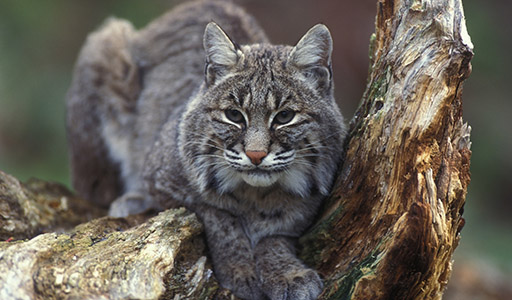Bobcats

Bobcat Information
If you live in a rural area, you may have come across a large paw print on the grounds of your property. If you have, there is a good chance that this print belongs to a bobcat. These large cats are becoming increasingly common across many parts of the United States.

What does a Bobcat look like?
These medium-sized wildcats are around two to three times bigger than large house cats, weighing from 15 to 30 pounds and reaching about three feet in length. They are also distinguished from domestic cats by the tufts of fur on their cheeks and ears. Bobcats can be various shades of buff and brown with dark brown or black stripes and spots.

What does a Bobcat eat?
Bobcats are carnivores that prey on a variety of animals. Typical meals include mice, voles, rabbits, gophers, and even small deer. They may also eat insects, reptiles, birds, and animal carcasses if food is scarce. Hunting primarily by sight and sound, bobcats stalk their prey, waiting patiently until it’s within reach. When they take down animals too large to eat at once, the pests may cover their meals with leaves or snow and save it for later.

Bobcat habits
Distributed from coast to coast in the U.S., bobcats live in forests, swamps, farmlands, and arid areas with plenty of rocks and brush. They often use rock cliffs, outcroppings, ledges, hollow trees, or large brush piles for shelter and nesting sites.
Encounters With People and Pets
Due to their ability to stay hidden, bobcats rarely come into conflict with humans. Still, they should not be taken lightly. They are dangerous animals with the speed to take down a deer, as well as sharp teeth and claws. Pets left outdoors can be snatched for food, with no evidence left behind but a few bobcat tracks. When homeowners suspect bobcats have been entering the yard, Trutech can assess the situation and take appropriate action.
Physical Attributes
When trying to determine which species you are dealing with, consider bobcat vs lynx size. The Canadian lynx appears more slender and has proportionately larger feet. Another characteristic that helps homeowners tell them apart is color. Bobcats have coats that vary from beige to dark brown, whereas lynxes can appear grayish.
Frequently Asked Questions
Predators like bobcats are never welcome around homes, so finding their droppings on the lawn can be worrying. To determine which pest is causing the problem, a few facts about coyote scat vs. bobcat scat identification may help. Similar in size and appearance, the droppings of both pests are large, brown to black in color, and tubular-shaped. The most reliable way to tell them apart is to check for surrounding animal signs. Bobcat poop is often located near urine-soaked mounds called scratch piles used to mark territory. These droppings are frequently covered with dirt, snow, or leaves.
Although prevalent in pockets across the U.S., bobcats are rarely seen due to their cautious nature. Bobcat tracks are approximately twice the size of those made by a domestic house cat. They show four toes and a heel with two pads on the front and three on the back. No claw marks are visible because bobcat claws are retractable.
Bobcat tracks in mud will show great detail when they dry. Because it’s harder for their small feet to maintain traction, these pests keep winter travel to a minimum. Therefore, it is rarer to see bobcat tracks in snow.
Though people commonly consider them to be two different animals, a bobcat is actually a species of lynx. Still, not all lynxes are bobcats, so proper identification is important when it comes to control. Other species of lynx include the Canadian, Iberian, and Eurasian varieties. Most sightings in the US turn out to be bobcats because the Canadian lynx is rarely spotted south of the Canadian border.
When trying to determine which species you are dealing with, consider bobcat vs lynx size. The Canadian lynx appears more slender and has proportionately larger feet. Another characteristic that helps homeowners tell them apart is color. Bobcats have coats that vary from beige to dark brown, whereas lynxes can appear grayish.


